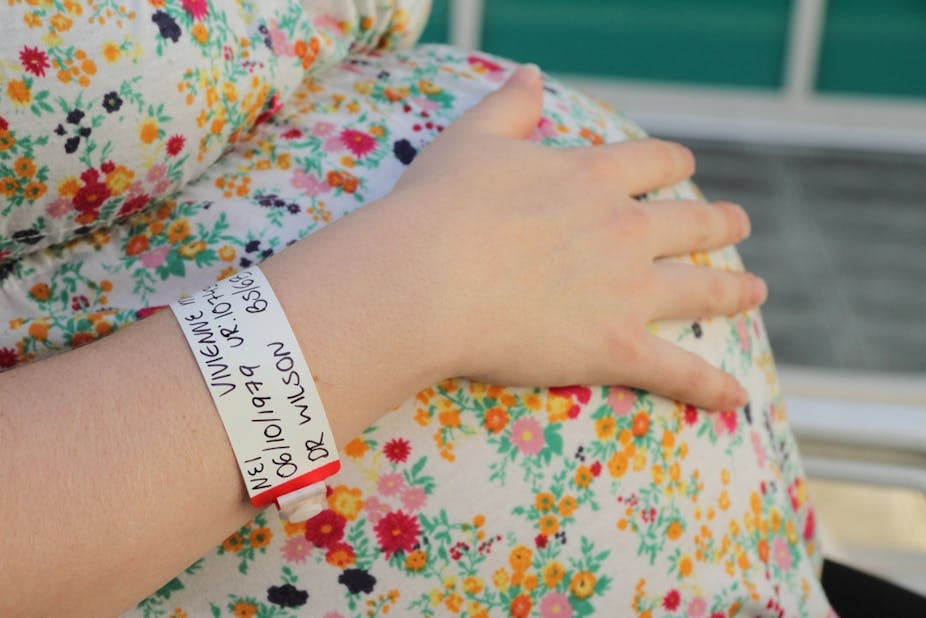Think of childbirth and you’re likely to picture a woman lying on her back on a hospital bed. That’s the position most (78%) Australian women adopt to give birth birth, despite growing evidence that being upright to give birth can have better outcomes for the mother and baby.
Historical and anthropological literature shows that lying down for birth is a relatively modern phenomenon, as we have moved from a more social to a surgical model of care. As far back as written records, carvings and paintings go, women have given birth upright – whether it was using stacked bricks to create a primitive birthing stool or holding onto leaves and ropes hung from trees. A famous drawing from Egypt depicts Cleopatra (69-30 BC) kneeling to give birth.
The birthing chair or stool dates back to Babylonian times (2000 BC). In cultures where Western medicine has had less of an impact, we still see these practices today. A 1961 survey found that giving birth while laying down was the norm in just 18% of traditional cultures. These findings were similar to those of the anthropologist Engelmann nearly 100 years earlier (1882).
So what happened 300 years ago to change this?
Let’s first look to France, which was the early leader in obstetric practice. In 1598, barber surgeon Jacques Guillemeau (one of the first obstetricians) advocated reclining in a bed for birth. The emergence of obstetric instruments over the next 50 years, along with the use of episiotomy (where the vaginal wall is surgically cut to assist delivery), and finally anaesthetic, facilitated this shift in birth positions.
One of the first hospitals with a maternity section, the famous Paris Hotel Dieu, used a special bed for delivery. Some scholars claim the French King Louis XIV (1637-1709) enjoyed watching women give birth (including his mistresses) and found his view obstructed on the birth stool, so encouraged the use of the lying down position.

However, there were midwives challenging this practice, including the famous French midwife Louise Bourgeois (1563-1636), known as the King’s midwife due to her position as midwife to the royal court:
Vertical positions are the most natural, the most instinctive; gravity seems to aid and hasten the birth…Lying high up on the bed is far less natural….
The movement of birth from home to hospital in most resource-rich countries during the 1900s altered this on a grand scale. And like most things in childbirth, no research was undertaken to see if it was good thing. In the popular King’s Eclectic Obstetrics medical text book published in 1900, the following is written:
I do not think that the delivery proceeds with so much ease and rapidity, nor is it so convenient for the practitioner in every respect, as when the female is placed upon the back.
A better way to deliver
Large reviews of the evidence show labouring upright and giving birth upright have advantages for the mother and baby. Apart from the obvious benefit of gravity to help the baby descend, these include:
- more efficient contractions
- shorter labour
- better oxygenation of the baby in the mother’s uterus, as the vena cava vein and aorta are not compressed by the pregnant uterus
- increased pelvic diameter, especially in positions such as squatting
- less maternal pain
- greater satisfaction
- fewer forceps, vacuum births and episiotomies.
So why most Australian women give birth on their backs? Curious to understand this, my colleagues and I undertook an ethnographic study (using observations and interviews) looking at how women gave birth in the three different birth settings: hospitals, birth centres and at home.
We discovered that the way we have constructed the birth environment, such as putting the bed in the centre of the room and having little supportive equipment (such as birth balls, birth stools, mats and bean bags) had a major subliminal impact on both the way women and midwives acted.
When the women weren’t directed by midwives or obstetricians, and the environment facilitated their moving about adopting different positions, the majority gave birth upright and forwards leaning - the total opposite to what happens when a woman gives birth on her back on a bed.
Giving women information before the birth and helping them practice different positions also helped facilitate this, as did continuity of midwifery care and creating home-like environments.
While Australia seems to be behind the times, leading international bodies such as National Institute for Health and Care Excellence NICE in the United Kingdom recommend:
Women should be discouraged from lying supine or semi-supine in the second stage of labour and should be encouraged to adopt any other position that they find most comfortable.
So, what began as a change in birth positions for the convenience of men has been shown scientifically to be an inconvenience for women and babies. It’s time for Australian women to stand and deliver once again.

